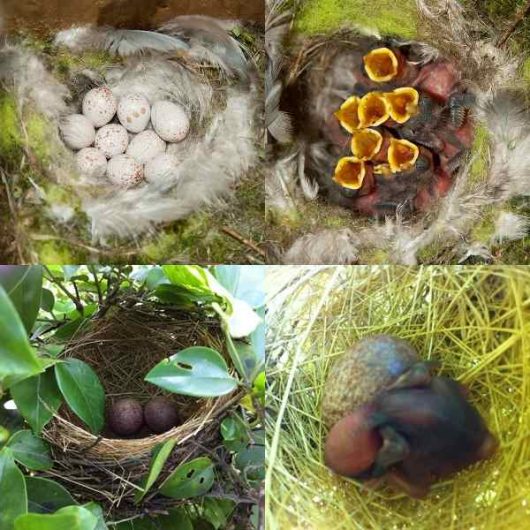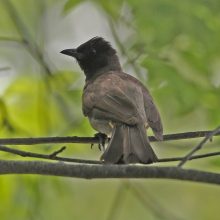Why does the Common Bulbul breed year-round despite predictable seasonal aridity?
LINKED PAPER
Weak breeding seasonality of a songbird in a seasonally arid tropical environment arises from individual flexibility and strongly seasonal moult. Nwaogu, C.J., Tieleman, B.I. & Cresswell, W. 2018. IBIS. DOI: 10.1111/ibi.12661. VIEW
Early ornithological observations outside temperate systems raised an important question: “Why don’t all tropical birds reproduce seasonally when they are in seasonal environments, when temperate birds always reproduce seasonally?” The answer, of course, is overall fitness, and the differing life history possibilities that can occur in less seasonally harsh tropical environments.
Fitness is defined as the number of viable offspring produced during the life time of an organism. But there are two ends of a continuum of how to do this: small clutches for many years or large clutches for a few years. Seasonal harshness and unpredictability during the winter season usually leads to all resident temperate birds having the former strategy because only few live very long, while a relaxation of harsh conditions and unpredictability allows selection for the latter strategy, as annual survival rates can be much higher in tropical areas. But there is an added problem in tropical areas: increased probability of nest predation that further selects for the latter strategy.

I have been studying the annual cycle of Common Bulbuls, Pycnonotus barbatus, in tropical West Africa. A temperate Blue Tit, Cyanistes caeruleus, may raise 5 – 7 chicks per year (perhaps even more) while a tropical Common Bulbul may raise only 2 chicks in three years due to high nest predation and small clutch sizes. If both species need to raise 10 chicks over their life time, a Blue Tit can achieve this within 2 – 3 years while a Common Bulbul needs 15 years. Raising several chicks may entail lower survival, hence a Blue Tit may only survive few years, alternatively, the Blue Tit must raise several chicks in few years if it cannot breed beyond 3 – 4 years because of the harsh temperate winters. To raise a brood of seven chicks, a Blue Tit also needs to breed at the most productive part of the year, so that it can adequately nourish its young. A Blue Tit chick can consume 100 caterpillars per day in days prior to fledging – imagine raising seven (or more) of those!
Common Bulbuls should differ in their annual priorities, and this may govern how they organise their annual cycles: Blue Tits should prioritise the timing of breeding annually while Common Bulbuls should prioritise the timing of self-maintenance traits like moult to enhance survival. Common Bulbul fitness is likely to be defined by longevity and number of successful breeding events over a life time.

In our recently published paper, we tested how breeding and moult are organised into the annual cycle of the Common Bulbul in a seasonally arid West African environment. We found evidence for strict seasonal timing of moult to the wet season, but no evidence for seasonal breeding despite predictable seasonal aridity. Why should bulbuls moult in the wet season but breed at any time?

Our results suggest that timing of moult is independent of breeding. Moult seems prioritised over breeding because of its contribution to annual survival through self-maintenance. Breeding increases fitness if successful, but moult enhances survival and future reproduction, so moult should be a priority for timing because breeding outcomes are unpredictable. Common bulbuls have a very high nest predation rate – up to 89% – so investment in any breeding attempt, or timing it perfectly to peak resource availability is unlikely to get much payoff. Instead, timing moult to the best period in the annual cycle is a more reliable way to increase fitness because breeding can happen at any time during year. Incubating females bulbuls simply need to carry extra body reserves to manage the higher foraging cost of breeding in the dry season (Nwaogu et al. 2017).
However, prioritising self-maintenance over breeding is not a sustainable strategy unless breeding is eventually successful. Common Bulbuls seem to manage this by optimising the value of successfully fledged chicks or surviving clutches: If any breeding attempt avoids predation, adults remain in family groups with chicks for up to 12 weeks helping young to survive. Even so, whether breeding is successful or not, bulbuls still moult at the right time indicating its overall importance, although, females may delay moult relative to males, perhaps because of their greater willingness to invest in repeat clutches or post-fledging chick care.

So a nice example of how selection operates differently in terms of life history in temperate and tropical areas – but there is a danger of generalising that Common Bulbuls represent the norm for tropical areas. Tropical systems are diverse, such that life history conclusions drawn from temperate birds or particular tropical systems cannot be generalised. Two studies by Phillip Stouffer and co-workers (Johnson et al. 2012, Stouffer et al 2013) showed huge diversity in the timing of breeding and moult in central Amazonian rainforest birds. Such diversity within a tropical system suggest that temperate birds may simply represent a node of life history diversification rather than a life history opposite of tropical birds. There seem to be several ways of fitting breeding and moult into the relatively fixed annual cycles of birds, and these may depend largely on their relative fitness benefit rather than the occurrence of seasonal environmental conditions. The key thing is always to think about lifetime reproductive success – fitness – rather than seasonal productivity.
References
Johnson, E.I., Stouffer, P.C. & Bierregaard, J., Richard O. 2012. The phenology of molting, breeding and their overlap in central Amazonian birds. J. Avian Biol. 43: 141–154. VIEW
Nwaogu, C.J., Dietz, M.W., Tieleman, B.I. & Cresswell, W. 2017. Breeding limits foraging time: evidence of interrupted foraging response from body mass variation in a tropical environment. J. Avian Biol. 48: 563–569. VIEW
Stouffer, P.C., Johnson, E.I. & Bierregaard, R.O. 2013. Breeding seasonality in central Amazonian rainforest birds. The Auk 130: 529–540. VIEW
Image credits
Featured image: Common Bulbul, Pycnonotus barbatus | Lip Kee Yap | CC BY-SA 2.0
If you want to write about your research in #theBOUblog, then please see here.





